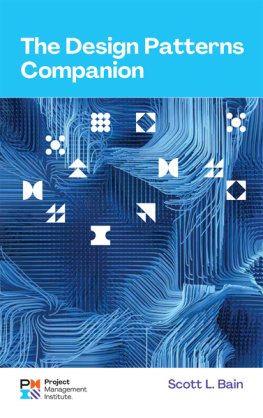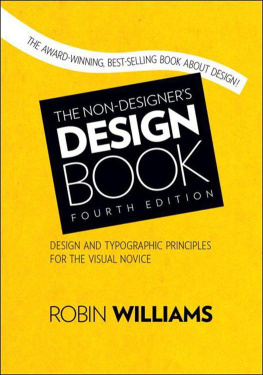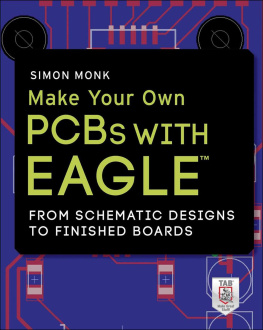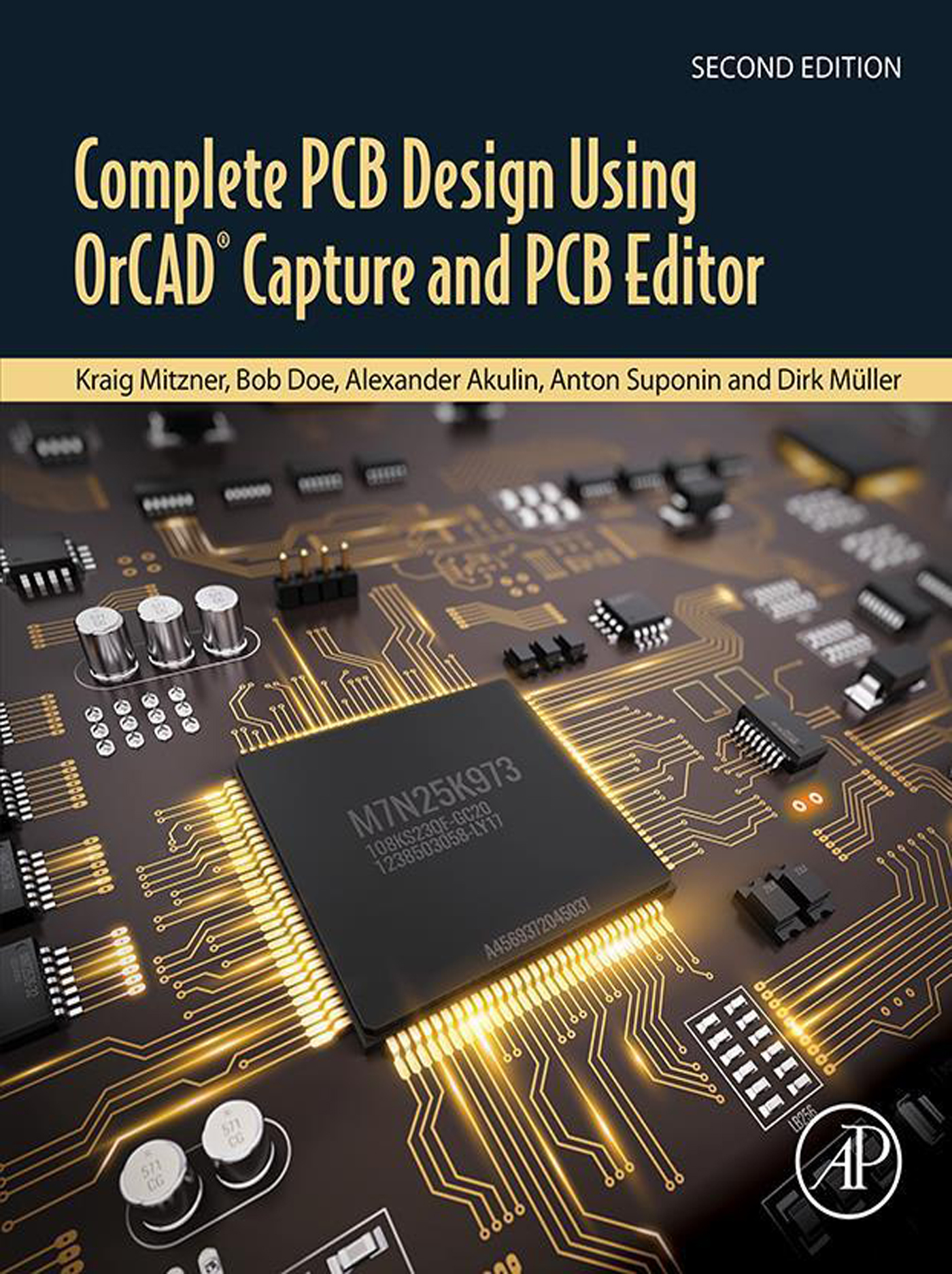Table of Contents
List of tables
- Tables in Chapter 1
- Tables in Chapter 4
- Tables in Chapter 5
- Tables in Chapter 6
- Tables in Chapter 7
- Tables in Chapter 8
- Tables in Chapter 9
- Tables in Chapter 10
- Tables in Appendix B
- Tables in Appendix D
List of illustrations
- Figures in Chapter 1
- Figures in Chapter 2
- Figures in Chapter 3
- Figures in Chapter 4
- Figures in Chapter 5
- Figures in Chapter 6
- Figures in Chapter 7
- Figures in Chapter 8
- Figures in Chapter 9
- Figures in Chapter 10
- Figures in Chapter 11
- Figures in Chapter 12
Landmarks
Table of Contents
Complete PCB Design Using OrCAD Capture and PCB Editor
Second Edition
Kraig Mitzner
Independent Consultant, Washington, United States
BOB DOE
Parallel Systems Ltd, Bracknell, United Kingdom
Alexander Akulin
Co-founder of PCB Soft Ltd., PCB Technology, Moscow, Russia
Anton Suponin
PCB Soft, Moscow, Russia
Dirk Mller
FlowCAD, Feldkirchen, Germany

Copyright
Academic Press is an imprint of Elsevier
125 London Wall, London EC2Y 5AS, United Kingdom
525 B Street, Suite 1650, San Diego, CA 92101, United States
50 Hampshire Street, 5th Floor, Cambridge, MA 02139, United States
The Boulevard, Langford Lane, Kidlington, Oxford OX5 1GB, United Kingdom
Copyright 2019 Elsevier Inc. All rights reserved.
No part of this publication may be reproduced or transmitted in any form or by any means, electronic or mechanical, including photocopying, recording, or any information storage and retrieval system, without permission in writing from the publisher. Details on how to seek permission, further information about the Publishers permissions policies and our arrangements with organizations such as the Copyright Clearance Center and the Copyright Licensing Agency, can be found at our website: www.elsevier.com/permissions.
This book and the individual contributions contained in it are protected under copyright by the Publisher (other than as may be noted herein).
Notices
Knowledge and best practice in this field are constantly changing. As new research and experience broaden our understanding, changes in research methods, professional practices, or medical treatment may become necessary.
Practitioners and researchers must always rely on their own experience and knowledge in evaluating and using any information, methods, compounds, or experiments described herein. In using such information or methods they should be mindful of their own safety and the safety of others, including parties for whom they have a professional responsibility.
To the fullest extent of the law, neither the Publisher nor the authors, contributors, or editors, assume any liability for any injury and/or damage to persons or property as a matter of products liability, negligence or otherwise, or from any use or operation of any methods, products, instructions, or ideas contained in the material herein.
British Library Cataloguing-in-Publication Data
A catalogue record for this book is available from the British Library
Library of Congress Cataloging-in-Publication Data
A catalog record for this book is available from the Library of Congress
ISBN: 978-0-12-817684-9
For Information on all Academic Press publications visit our website at https://www.elsevier.com/books-and-journals
Publisher: Mara Conner
Acquisition Editor: Tim Pitts
Editorial Project Manager: Ana Claudia A. Garcia
Production Project Manager: Nirmala Arumugam
Cover Designer: Alan Studholme
Typeset by MPS Limited, Chennai, India

Acknowledgments
The authors would like to thank Cadence for the use of the software and the technical assistance during the development of this book.
The authors would also like to thank their families and friends for their support and encouragement without which this book would not have been completed.
And last, but not the least, a hearty thank you goes to the readers of the first book. Your enthusiasm and feedback provided the motivation to create the second edition of this book.
Introduction
The OrCAD PCB design solutions provide a comprehensive suite of tools for design entry, using OrCAD Capture, mixed-signal circuit simulation using OrCAD PSpice, and physical layout using OrCAD PCB Editor for mainstream electronic circuit designs.
OrCAD PCB Editor is based on Allegro PCB Editor, so this book will be useful to new Allegro PCB Editor users as well. Allegro PCB Editor is a powerful, full-featured design tool. While OrCAD PCB Editor has inherited many of those features, including a common file format, it does not possess all of the capabilities available to the Allegro PCB tiers, such as Allegro High-Speed Option, Analog/RF Option, FPGA System Planner, Design Planning, and Miniaturization Option. Consequently most of the basic tools and features are described here, but only a few of the more-advanced tools are covered, as outlined later.
, Introduction to printed circuit board design and computer-aided design, introduces the reader to the basics of printed circuit board (PCB) design. The chapter begins by introducing the concepts of computer-aided engineering, computer-aided design (CAD), and computer-aided manufacturing. The chapter then explains how these tools are used to design and manufacture multilayer PCBs. Many 3D pictures are used to show the construction of PCBs. Topics such as PCB cores and layer stack-up, apertures, D-codes, photolithography, layer registration, plated through holes, and Gerber files are explained.
, Project structures and the PCB Editor tool set.
, Introduction to the printed circuit board design flow by example. Gerber files are also explained in detail.
, Introduction to industry standards, introduces some of the industry standards organizations related to the design and fabrication of PCBs (e.g., IPC and JEDEC). PCB performance classes and producibility levels are also described, along with the basic ideas behind standard fabrication allowances. These concepts are described here to help the reader realize some of the fabrication issues up front to help minimize board failures and identify some of the guides and standards resources that are available for PCB design.
, Introduction to design for manufacturing, addresses the mechanical aspect of PCB designdesign for manufacturability. The chapter explains where parts should be placed on the board, how far apart, and in what orientation from a manufacturing perspective. OrCAD PCB Editors design rule checker is then considered relative to the manufacturing concepts and IPCs courtyard concepts. To aid in understanding the design issues, manufacturing processes such as reflow and wave soldering, pick-and-place assembly, and thermal management are discussed. The information is then used as a guide in designing plated through holes, surface-mount lands, and PCB Editor footprints in general. Tables summarize the information and serve as a design guide during footprint design and PCB layout.







